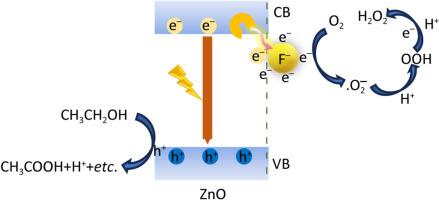当前位置:
X-MOL 学术
›
J. Materiomics
›
论文详情
Our official English website, www.x-mol.net, welcomes your
feedback! (Note: you will need to create a separate account there.)
F− surface modified ZnO for enhanced photocatalytic H2O2 production and its fs-TAS investigation
Journal of Materiomics ( IF 8.4 ) Pub Date : 2024-11-20 , DOI: 10.1016/j.jmat.2024.100974 Xin Zhou, Chenbin Ai, Xiaojing Wang, Zhen Wu, Jianjun Zhang
Journal of Materiomics ( IF 8.4 ) Pub Date : 2024-11-20 , DOI: 10.1016/j.jmat.2024.100974 Xin Zhou, Chenbin Ai, Xiaojing Wang, Zhen Wu, Jianjun Zhang

|
Pure ZnO exhibits low photocatalytic H2O2 production activity due to the rapid charge recombination. To realize the spatial separation of photogenerated electrons and holes, constructing an electron transfer channel on the ZnO surface is an effective approach. This study successfully modified the surface of ZnO using F− (ZnO/F) by introducing NH4F in an aqueous phase photocatalytic system. The F− is adsorbed on the ZnO surface by Coulombic force and significantly improves the photocatalytic H2O2 production performance of ZnO, with the highest efficiency of 4137.2 μmol⋅g−1·L−1·h–1. The photocatalytic performance enhancement mechanism of ZnO/F is explained in terms of electron transfer dynamics by femtosecond transient absorption spectroscopy (fs-TAS) measurements. F− surface modification constructs a new ultrafast electron transport pathway from the ZnO CB to F−, and the optimal ZnO/F exhibits the fastest interfacial electron transfer lifetime of 5.8 ps. The F− surface modification effectively facilitates the charge separation, thereby increasing the number of electrons available for photocatalytic H2O2 reaction. This study has revealed the roles of F− surface modification in the photocatalytic H2O2 production by ZnO and provides guidance for ionic modification to improve photocatalytic performance.
中文翻译:

用于增强光催化 H2O2 生产的 F− 表面改性 ZnO 及其 fs-TAS 研究
由于快速电荷复合,纯 ZnO 表现出低光催化 H2O2 产生活性。为了实现光生电子和空穴的空间分离,在 ZnO 表面构建电子转移通道是一种有效的方法。本研究通过在水相光催化系统中引入 NH4F,成功地使用 F-(ZnO/F)修饰了 ZnO 的表面。F− 被库仑力吸附在 ZnO 表面,显著提高了 ZnO 的光催化 H2O2 生产性能,最高效率为 4137.2 μmol⋅g−1·L−1·h−1。通过飞秒瞬态吸收光谱 (fs-TAS) 测量从电子转移动力学的角度解释了 ZnO/F 的光催化性能增强机制。F− 表面改性构建了一条从 ZnO CB 到 F− 的新的超快电子传递途径,最佳 ZnO/F 表现出最快的界面电子转移寿命,为 5.8 ps。F− 表面改性有效地促进了电荷分离,从而增加了可用于光催化 H2O2 反应的电子数量。本研究揭示了 F− 表面改性在 ZnO 光催化 H2O2 中的作用,并为离子改性以提高光催化性能提供了指导。
更新日期:2024-11-20
中文翻译:

用于增强光催化 H2O2 生产的 F− 表面改性 ZnO 及其 fs-TAS 研究
由于快速电荷复合,纯 ZnO 表现出低光催化 H2O2 产生活性。为了实现光生电子和空穴的空间分离,在 ZnO 表面构建电子转移通道是一种有效的方法。本研究通过在水相光催化系统中引入 NH4F,成功地使用 F-(ZnO/F)修饰了 ZnO 的表面。F− 被库仑力吸附在 ZnO 表面,显著提高了 ZnO 的光催化 H2O2 生产性能,最高效率为 4137.2 μmol⋅g−1·L−1·h−1。通过飞秒瞬态吸收光谱 (fs-TAS) 测量从电子转移动力学的角度解释了 ZnO/F 的光催化性能增强机制。F− 表面改性构建了一条从 ZnO CB 到 F− 的新的超快电子传递途径,最佳 ZnO/F 表现出最快的界面电子转移寿命,为 5.8 ps。F− 表面改性有效地促进了电荷分离,从而增加了可用于光催化 H2O2 反应的电子数量。本研究揭示了 F− 表面改性在 ZnO 光催化 H2O2 中的作用,并为离子改性以提高光催化性能提供了指导。































 京公网安备 11010802027423号
京公网安备 11010802027423号